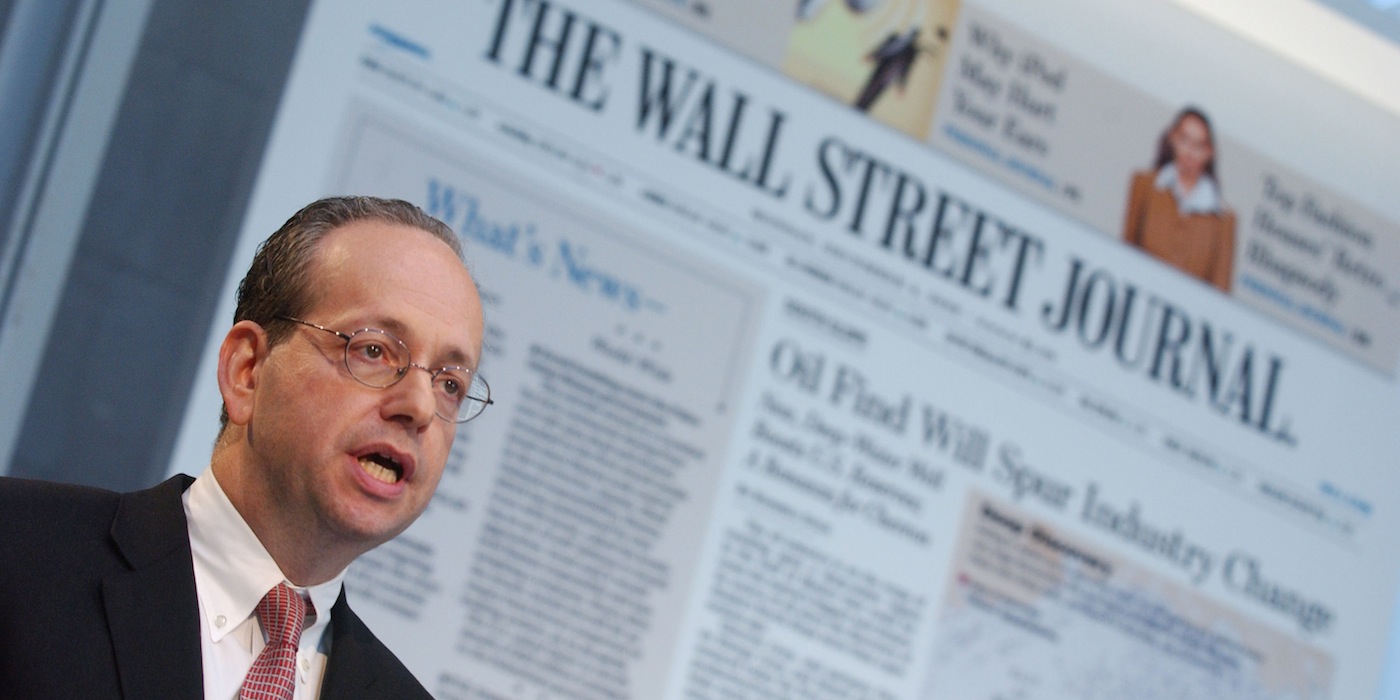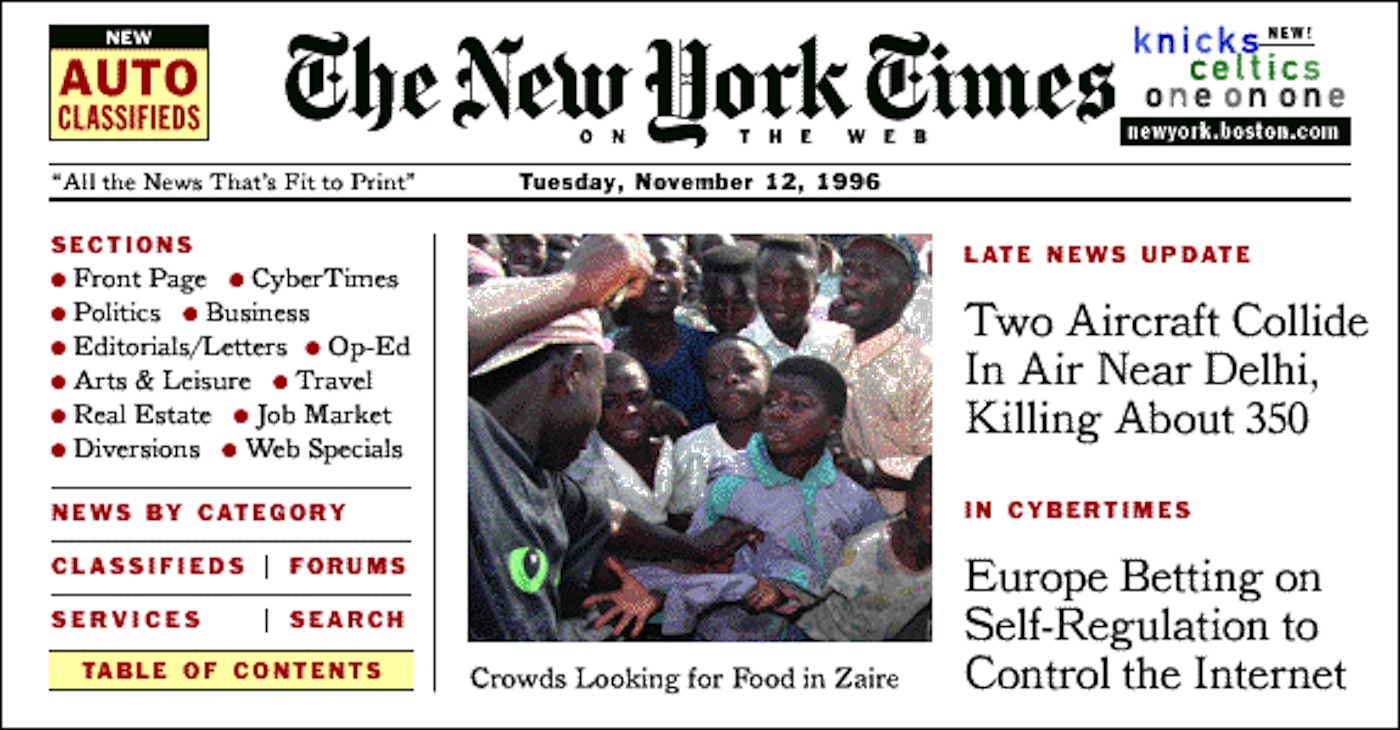Chapter 6
The Return of Newspapers

I was back in New York and Neil Budde, who was later the founding editor of The Wall Street Journal’s website, showed a group of us this unbelievable product, which was the first iteration of The Wall Street Journal’s website built on HTML.
He explained how he had done it, and he explained this HTML. It was the most amazing thing I’d ever heard. We saw the demo, and I asked him at the end of the meeting, I said, “That was fantastic but how many months is it going to take to produce that?”
He replied, “Time to produce it?”…He looked at me and said, “I don’t think you understand. It’s live now.”
The contrast between electronic publishing in the old days, the pre-Internet days, and the Internet couldn’t have been more stark to me.
That contrast wasn’t just in the magic of the creation tools and the previously unthought-of speed-to-market; it was also transformational to the business model. Suddenly, the web made it possible for publishers to easily bypass the proprietary services; to own their customers; and to avoid any notion that an intermediary could determine whether, and what, would be published. This was the biggest, freest printing press the world had ever seen. Honestly, not since Gutenberg. Of course, as it turned out, that knife cut both ways.
For a lot of people, you were interested in the First Amendment idea, that right to publish. In the early days of the Internet, people felt, “We have a distributed system. That means something which is not controlled by government or anybody else.”
That was driving a lot of people. That drove a lot of the excitement. Certainly, the early geeks were excited to be able to work together without asking anybody’s permission. Some of the initial publishers who realized, “Oh my goodness, I can start a newspaper just like that.”
One of the newspaper executives who sensed that power early on was Alan Spoon, who was president of the Washington Post Company. Spoon was a “geek” from MIT with a law degree from Harvard, and he was familiar with the Internet well before Berners-Lee invented the World Wide Web.
Don Graham and I were making a sales call in Chicago to a major client. We were going to the airport in Chicago. I was talking about the web and how it was coming on. Don and I always put our heads together in these things. We decided, “You know what? We’ve got to get to the web.”
So, forced march. Cellphone call from the back of the cab: “Changing strategy. We need to move off of the proprietary system.” Because as I always put it, “We are winning the county track meet but the Olympics lay ahead.” We have to have a hell of a lot more subscriptions than that [referring to their 30,000 AT&T Interchange users]. We shifted the model from pay to advertiser-supported.
By now, of course, a number of free news services already existed on the web. Yahoo News and CNN.com were giving it away to one and all. And Knight Ridder had changed its strategy from a paid service on AOL to a free one on the web:
I don’t think that was a bad decision because we had to build up a big enough audience so we had something to sell [to advertisers], and I don’t know if we would have built up that audience absent that.
Meanwhile, at The Wall Street Journal, the plan was to launch a pay site:
There was never really much of a debate. The debate was really, “How much do we charge?” It was never, “Is this going to be free?” I think one reason for that is that unlike most newspaper companies, Dow Jones, since its very beginning, since even before The Wall Street Journal, was selling news electronically to subscribers. The whole revenue base was subscriptions for what’s now the Dow Jones Newswire and other services.

We made a recommendation that was somewhat controversial at the time, although we made it in the context of other folks having made the same decision, to offer [The Times] website for free. Many people have said that this was a good decision. Many people have said this was a terrible decision.
There are people, in fact, who we’ve interviewed, that are on both sides of that. I just wanted to get your thoughts in retrospect. Do you think it was the right decision to offer The Times on the web for free at that time?
The answer is, absolutely, I do. I do for a couple of different reasons: The first is, we didn’t know what the business model was going to be. It was so early in that system; to see what kind of audience we could build; what kind of tools we needed; at a time when this was a highly profitable newspaper company….
Two, I think by offering it free, we found it easier to engage our journalists in building the digital muscles that we needed to make this really work because, as you recall, the newsroom embraced it in theory but not really in their heart.
Newsrooms, as you know, are mission-driven organizations. They saw this in the early stage as getting in the way of the mission. The mission was getting the best quality information into the hands, literally, of people who were holding paper. But once they started to see what kind of reach they could get, once they started to get feedback from people living outside of the United States who had read their stories on this thing called the web, they started to say, “Wait, this is core to the mission.”
I think it would have been a harder sale had there been an element of charging for it, in making that transition.
By 1996, virtually every mainstream news organization, from national to local, broadcast, cable, and print, had some kind of news presence on the web. Most were free, and in most cases, the website “brands” reflected the idea that the web was seen primarily as a way to “repurpose” existing editorial (and wire) content. This was certainly true at the dominant papers — The Times, The Journal, USA Today and The Washington Post — all of whom created brand extensions on the web. Some local organizations, however, went another way. A team at The Boston Globe created a local portal called Boston.com. The Newhouse newspaper organization, as noted above, created NJ.com and hired Jeff Jarvis to run it.
There was much debate about that — I think there still is today — about the brand question, everywhere. But the belief was this is something entirely new. It was going to combine multiple newspapers in some of the Newhouse markets. In Michigan we had eight papers; in Alabama, we had three papers. So you could have a statewide service.
In fact, it started as “New Jersey Online” at NJ.com. One lesson we learned was that your brand and URL had to be the same. It was rebranded again to, simply, NJ.com. They’ve stuck with that.
While the newspapers wrestled with issues of branding and business model, “native” web journalism organizations bloomed across the Internet. Two recent college graduates, Steven Johnson and Stefanie Syman, created FeedMag, one of the first and best online “zines.” Joey Anuff and Carl Steadman created Suck.com. Their tagline: “A fish, a barrel, and a smoking gun.” In 1994, Cool Site of the Day was launched by Glenn Davis to celebrate this great flowering of Internet content, broadcast to an emerging generation of online enthusiasts. Suddenly, everyone was a publisher.
Early on there were some things which I think people noticed. There were some firsts from my point of view. When I followed a link at Franz Herzl’s Vatican, he had an online hypertext exhibit of Vatican Renaissance artwork that had been scanned by the Library of Congress.
He found the stuff on the FTP [file transfer protocol] server and had made webpages out of it. I went through his museum and clicked on a little thumbnail and I found this beautiful — I’ve got it on my computer still — beautiful illuminated manuscript. It had a nice color screen. That was just great because this was showing how you could really see great art on it.
Then Steve Putz was the first person to make a map server. You could click and you would move to a slightly different part of the world, and it would draw you a map every time. I think it was done with the U.S. census data, the TIGER data. That was another trigger.
The moment Steve puts up that very crude map server, everybody realized, “Oh my goodness! Every webpage is just a virtual idea. I have to write a program, which will draw, or paint the right version of that idea when somebody clicks on the link, and I can make links to other ones.” So they realize with just a few lines of code, Steve had produced this world of maps of the U.S. at any scale.
Around that time, others were thinking about how this might apply to a variety of emerging online publishing and advertising opportunities. One was Jeff Taylor, whose 1994 startup, the Monster Board, would become the largest job search site for many years, severely disrupting newspaper help wanted advertising, one of the industry’s largest and most profitable advertising categories. Another was a young journalist and entrepreneur named Larry Kramer, who was thinking about how to craft a new business model for online business information:
Now, it’s ’94, ’95, and I’m going, “Something big is happening.” A lot of people are starting to trade stocks at home and are getting very disillusioned with brokers. I’m thinking everybody’s getting these IPOs. Netscape happened, a few things started to happen, and I can do that. My broker isn’t getting me anything. The brokerages started coming online with discount brokerages. Schwab and E*TRADE and things were all popping up.
A whole new community of people was coming up who wanted financial data at home and were trading stocks. It looked to me like the Internet could replicate a Bloomberg terminal pretty closely. Not everything, obviously, or a Reuters terminal at a home, [but] for much less money if you have real time. There’s no way of getting around the fact that the exchanges would charge you for real-time data. You’d have whatever that charge, but it was in hundreds, low hundreds, not thousands.
The rest of it was on this thing, the Internet. If I could build a news service that could even approach some of what they wanted…. My strategy was, most of these home traders were trading a basket of stocks — the Internet stocks at the time, which were starting to get very volatile.
If I started a news organization that covered the most-traded stocks by volume, I would be attracting a large audience.
Kramer wanted to align with a major media partner to get the credibility of their brand and promotion. One of the companies he approached was CBS. His initial contact was a young business development manager named Derrick Ricefield.
Derrick saw it right away. He went back and talked to [CBS News president] Andrew Heyward, and my next meeting was with Andrew Heyward. I flew to New York, and I knew this could go either way. Andrew and I are contemporaries. We didn’t know each other, but we had a lot of mutual friends. He had been a Harvard undergraduate when I was at the [Harvard] Business School.
We had a lot of things in common. He knew that I’d been at The Washington Post. At that point, I was a respected editor in his mind. I said, “I don’t know how you’re going to react to this,” because in my days at The Washington Post if somebody came in and said, “We’ll cover financial news for you,” the window wouldn’t have been big enough to throw them out of. It’s like, who do you think you are?
He took the exact opposite approach. He said, “No. We really need help covering business.” He was totally open to the discussion.
CBS MarketWatch was born and quickly became one of the largest business news sites on the web. It competed with other early attempts at financial news, including Jim Cramer’s TheStreet.com, and Quote.com, an early news aggregator. Brothers David and Tom Gardner launched the Motley Fool on AOL in 1994. TheStreet.com created a paywall, like The Wall Street Journal. MarketWatch remained free.
Now, you’ve decided that it’s free, right?
Free and ad supported. I had already started to build an ad team at that point. I was trying to hire Scot McLernon, who was the ad director of Quote.com. He kept saying, “No. I think Quote.com is too good a brand.” I said, “I think I can solve that problem for you.” I couldn’t tell him how, so he was very skeptical. Then the day we announced it, I sent him a note with just an eye [the CBS logo] on it, and he joined shortly thereafter. We were off to the races.
If WSJ.com had decided to go free like The Times did, would you have had any hope of making this work?
Much less. I don’t know. I really don’t know if I could have made it. I thank my lucky stars for the fact that the three big news organizations were all tied up on very expensive terminals….
In 2005, Dow Jones would pay $519 million to acquire MarketWatch and its huge audience.
One of the reasons I approached Larry to ask him — when CBS MarketWatch was an independent company — to ask him what the future of CBS MarketWatch might be, and would he be interested in being purchased by Dow Jones? One of the reasons for that discussion was, and this is going to be very hard to believe now, but at this time…The Wall Street Journal’s website was sold out in terms of online advertising at very high [rates].




